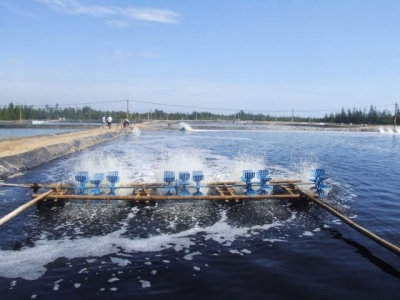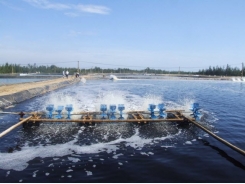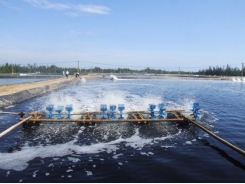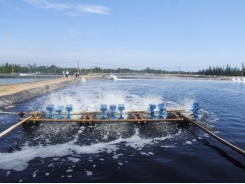The importance of biosecurity and disinfection in aquaculture (Part 4)

Viruses
Most viruses enter the fish by the mucosal linings of the gut or skin or by entering through gill tissue that has a thin cell membrane and a high surface area. In the gut the virus must survive acid conditions and then enter surrounding tissues to become infectious. In the fish slime, it must survive wandering macrophages (scavenger white blood cells) and at the gill sites, it must pass unrecognized by other white blood cells. If all this is done, the virus can initiate infection.
Once inside the fish the virus must then enter a host cell that permits replication. This is done by commandeering the machinery for normal DNA replication and using it for it’s own evil purposes. After doing this, it makes several million copies of itself until the cell is full, bursts and spreads viral particles to other cells, either within the host or sometimes, outside the host.

The virus can relay it’s disease attribute by cell lysis (disintegration), producing a toxic substance, changing host cell function or inserting a bit of it’s genetic material into the cells genome. The most common observation is cell lysis as the virus multiplies in number.
Bacteria

Bacteria play the numbers game too. They enter the fish by the same methods or by open wounds suffered through trauma. Once inside, bacteria use the fishes’ plumbing system, find a tissue that it likes (specific or non-specific) and sets up shop. Here the buggers multiply rapidly. The disease aspect of the bacteria is directly by tissue damage or by production of toxins. These toxins may be a result of metabolism or as a mechanism to protect the process of replication. The latter is almost a defense mechanism at the bacterial level. Either way, having too many bad bugs share your body is not a good thing.
Fungi

Fungi, like some other pathogens, are opportunistic, and are sometimes secondary infections to other fish health issues. Fungi send out hyphae (filaments) to attach themselves to nonspecific tissue that may be vulnerable or susceptible. From there they multiply spreading throughout the tissue utilizing the hosts valuable energy resources.
Parasites
Parasites may use fish as an intermediary or primary host. As an intermediate host, the fishes’ chances of overt disease signs are small. However, as a primary host, the fish is the environment the parasite has been living for. Parasites don’t generally kill the host, but they tend to alter behaviour and growth. The idea of having a macroscopic bug thriving to reproduce in you is not a pleasant one and it is easy to understand why the fish looks sick.
Antibiotics
Got an infection? Take a pill. But how does medication kill bugs? Antibiotics – those chemicals that kill bacteria – are also called antimicrobials and are of two general types: bacteriostatic and bacteriocidal.
Bacteriostatics prevent the bacteria from multiplying by inhibiting cell division. The fish then has time to develop an immune response and finishes off the resident bugs using its own defense system. Bacteriocidal medications kill the bacteria outright (how?). Antifungicides have similar effects on fungi by either inhibiting growth or by making changes to the cell wall and membrane of the fungus’ hyphae. Poking holes in the cells of fungi causes salt and ion penetration that kills the cell and hopefully the fungus.
Parasiticides
Parasiticides are usually specific in toxicity to the target organism. The real challenge here is to kill the invader while keeping the host intact. These compounds usually focus on some particular feature of the parasites’ anatomy or biology and exploit that weakness.
On the good side, pathogens don’t normally live long outside a host. This is because they are dependant on a host for most of the necessities of life. Some may aestivate (go dormant) as spores or such, but generally they die. This is also the time to disinfect.
If the pathogen is outside the fish, it’s much easier to kill it. Not only is the environment bad for the pathogen, there are also more tools that can be used to kill it. Selective toxicity is not necessary because you have isolated the pathogen and do not have to worry about the host. This is the principle of disinfection.
A good disinfectant will kill the pathogen and prevent growth of new pathogens. Of course, in a hatchery or farm situation, the disinfection process must be safe for humans, fish and the receiving environment otherwise some really nasty stuff could be used. Such uses would be irresponsible. The idea is to have a disinfectant that works with the efficiency of nuclear warfare, but without the aftermath. Biosecurity on fish farms has always been a challenge but there is no better time to kill a pathogen then when it is exposed, vulnerable and in search of a host.
Có thể bạn quan tâm
Phần mềm

Phối trộn thức ăn chăn nuôi

Pha dung dịch thủy canh

Định mức cho tôm ăn

Phối trộn phân bón NPK

Xác định tỷ lệ tôm sống

Chuyển đổi đơn vị phân bón

Xác định công suất sục khí

Chuyển đổi đơn vị tôm

Tính diện tích nhà kính

Tính thể tích ao hồ




 The importance of biosecurity and disinfection in aquaculture…
The importance of biosecurity and disinfection in aquaculture…  The importance of biosecurity and disinfection in aquaculture…
The importance of biosecurity and disinfection in aquaculture…